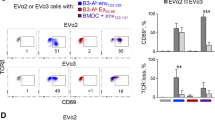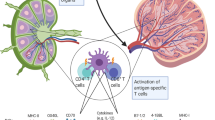Abstract
The ability of dendritic cells (DCs), genetically modified with one of two types of plasmid DNA vaccines to stimulate lymphocytes from normal human donors and to generate antigen-specific responses, is compared. The first type, also called “secreted” vaccine (sVac), encodes for the full length of the human prostate-specific antigen (PSA) with a signal peptide sequence so that the expressed product is glycosylated and directed to the secretory pathway. The second type, truncated vaccines (tVacs), encodes for either hPSA or human prostate acidic phosphatase (hPAP), both of which lack signal peptide sequences and are retained in the cytosol and degraded by the proteasomes following expression. Monocyte-derived dendritic cells are transiently transfected with either sVac or one of two tVacs. The DCs are then used to activate CD25+-depleted or nondepleted autologous lymphocytes in an in vitro model of DNA vaccination. Lymphocytes are boosted following priming with transfected DCs, peptide-pulsed DCs or monocytes. Their reactivity is tested against tumor cells or peptide-pulsed T2 target cells. Both tVacDCs and sVacDCs generate antigen-specific cytotoxic T-cell responses. The immune response is restricted towards one of the three antigen-derived epitopes when priming and boosting is performed with sVacDCs. In contrast, tVac-transfected DCs prime T cells towards all antigen-derived epitopes. Subsequent repeated boosting with transfected DCs, however, restricts the immune response to a single epitope due to immunodominance. While CD25+ cell depletion prior to priming with sVacDCs alleviates immunodominance, cotransfection of dendritic cells with GITR-L does so in some but not all cases.
This is a preview of subscription content, access via your institution
Access options
Subscribe to this journal
Receive 12 print issues and online access
$259.00 per year
only $21.58 per issue
Buy this article
- Purchase on Springer Link
- Instant access to full article PDF
Prices may be subject to local taxes which are calculated during checkout









Similar content being viewed by others
References
Mincheff M, Zoubak S, Altankova I, et al. Human dendritic cells genetically engineered to express cytosolically retained fragment of prostate-specific membrane antigen prime cytotoxic T-cell responses to multiple epitopes. Cancer Gene Ther. 2003;10:907–917.
Fong L, Brockstedt D, Benike C, et al. Dendritic cell-based xenoantigen vaccination for prostate cancer immunotherapy. J Immunol. 2001;167:7150–7156.
Eder JP, Kantoff PW, Roper K, et al. A phase I trial of a recombinant vaccinia virus expressing prostate-specific antigen in advanced prostate cancer. Clin Cancer Res. 2000;6:1632–1638.
Wolchok JD, Gregor PD, Nordquist LT, et al. DNA vaccines: an active immunization strategy for prostate cancer. Semin Oncol. 2003;30:659–666.
Mincheff M, Tchakarov S, Zoubak S, et al. Naked DNA immunizations for immunotherapy of prostate cancer. In: Annual Meeting of the American Urological Association. 1999 Dallas, TX.
Hicklin DJ, Wang Z, Arienti F, et al. beta2-Microglobulin mutations, HLA class I antigen loss, and tumor progression in melanoma. J Clin Invest. 1998;101:2720–2729.
Hiraki A, Kaneshige T, Kiura K, et al. Loss of HLA haplotype in lung cancer cell lines: implications for immunosurveillance of altered HLA class I/II phenotypes in lung cancer. Clin Cancer Res. 1999;5:933–936.
Dunn GP, Bruce AT, Ikeda H, et al. Cancer immunoediting: from immunosurveillance to tumor escape. Nat Immunol. 2002;3:991–998.
Ferrone S, Marincola FM . Loss of HLA class I antigens by melanoma cells: molecular mechanisms, functional significance and clinical relevance. Immunol Today. 1995;16:487–494.
Cordon-Cardo C, Fuks Z, Drobnjak M, et al. Expression of HLA-A,B,C antigens on primary and metastatic tumor cell populations of human carcinomas. Cancer Res. 1991;51(Part 1):6372–6380.
Rivoltini L, Barracchini KC, Viggiano V, et al. Quantitative correlation between HLA class I allele expression and recognition of melanoma cells by antigen-specific cytotoxic T lymphocytes. Cancer Res. 1995;55:3149–3157.
de la Salle H, Zimmer J, Fricker D, et al. HLA class I deficiencies due to mutations in subunit 1 of the peptide transporter TAP1. J Clin Invest. 1999;103:R9–R13.
van Duinen SG, Ruiter DJ, Broecker EB, et al. Level of HLA antigens in locoregional metastases and clinical course of the disease in patients with melanoma. Cancer Res. 1988;48:1019–1025.
Schreiber H, Wu TH, Nachman J, et al. Immunodominance and tumor escape. Semin Cancer Biol. 2002;12:25–31.
Ikeda H, Old LJ, Schreiber RD . The roles of IFN gamma in protection against tumor development and cancer immunoediting. Cytokine Growth Factor Rev. 2002;13:95–109.
Yewdell JW, Bennink JR . Immunodominance in major histocompatibility complex class I-restricted T lymphocyte responses. Annu Rev Immunol. 1999;17:51–88.
Sakaguchi S, Sakaguchi N, Asano M, et al. Immunologic self-tolerance maintained by activated T cells expressing IL-2 receptor alpha-chains (CD25). Breakdown of a single mechanism of self-tolerance causes various autoimmune diseases. J Immunol. 1995;155:1151–1164.
Suri-Payer E, Amar AZ, Thornton AM, et al. CD4+CD25+ T cells inhibit both the induction and effector function of autoreactive T cells and represent a unique lineage of immunoregulatory cells. J Immunol. 1998;160:1212–1218.
Shevach EM . Certified professionals: CD4(+)CD25(+) suppressor T cells. J Exp Med. 2001;193:F41–F46.
Levings MK, Sangregorio R, Roncarolo MG . Human cd25(+)cd4(+) t regulatory cells suppress naive and memory T cell proliferation and can be expanded in vitro without loss of function. J Exp Med. 2001;193:1295–1302.
Thornton AM, Shevach EM . CD4+CD25+ immunoregulatory T cells suppress polyclonal T cell activation in vitro by inhibiting interleukin 2 production. J Exp Med. 1998;188:287–296.
McHugh RS, Whitters MJ, Piccirillo CA, et al. CD4(+)CD25(+) immunoregulatory T cells: gene expression analysis reveals a functional role for the glucocorticoid-induced TNF receptor. Immunity. 2002;16:311–323.
Shimizu J, Yamazaki S, Takahashi T, et al. Stimulation of CD25(+)CD4(+) regulatory T cells through GITR breaks immunological self-tolerance. Nat Immunol. 2002;3:135–142.
Kim JD, Choi BK, Bae JS, et al. Cloning and characterization of GITR ligand. Genes Immun. 2003;4:564–569.
DeMars R, Chang CC, Shaw S, et al. Homozygous deletions that simultaneously eliminate expressions of class I and class II antigens of EBV-transformed B-lymphoblastoid cells. I. Reduced proliferative responses of autologous and allogeneic T cells to mutant cells that have decreased expression of class II antigens. Hum Immunol. 1984;11:77–97.
Matzinger P . The JAM test. A simple assay for DNA fragmentation and cell death. J Immunol Methods. 1991;145:185–192.
Parker KC, Bednarek MA, Hull LK, et al. Sequence motifs important for peptide binding to the human MHC class I molecule, HLA-A2. J Immunol. 1992;149:3580–3587.
Palmowski MJ, Choi EM, Hermans IF, et al. Competition between CTL narrows the immune response induced by prime-boost vaccination protocols. J Immunol. 2002;168:4391–4398.
Boden E, Tang Q, Bour-Jordan H, et al. The role of CD28 and CTLA4 in the function and homeostasis of CD4+CD25+ regulatory T cells. Novartis Found Symp. 2003;252:55–63 discussion 63–56, 106–114.
Wang HY, Lee DA, Peng G, et al. Tumor-specific human CD4+ regulatory T cells and their ligands: implications for immunotherapy. Immunity. 2004;20:107–118.
Kwon B, Kim BS, Cho HR, et al. Involvement of tumor necrosis factor receptor superfamily(TNFRSF) members in the pathogenesis of inflammatory diseases. Exp Mol Med. 2003;35:8–16.
Kohm AP, Williams JS, Miller SD . Cutting edge: ligation of the glucocorticoid-induced TNF receptor enhances autoreactive CD4(+) T cell activation and experimental autoimmune encephalomyelitis. J Immunol. 2004;172:4686–4690.
Draenert R, Le Gall S, Pfafferott KJ, et al. Immune selection for altered antigen processing leads to cytotoxic T lymphocyte escape in chronic HIV-1 infection. J Exp Med. 2004;199:905–915.
Bennink JR, Anderson R, Bacik I, et al. Antigen processing: where tumor-specific T-cell responses begin. J Immunother. 1993;14:202–208.
Masteller EL, Chuang E, Mullen AC, et al. Structural analysis of CTLA-4 function in vivo. J Immunol. 2000;164:5319–5327.
Doyle AM, Mullen AC, Villarino AV, et al. Induction of cytotoxic T lymphocyte antigen 4 (CTLA-4) restricts clonal expansion of helper T cells. J Exp Med. 2001;194:893–902.
Manzotti CN, Tipping H, Perry LC, et al. Inhibition of human T cell proliferation by CTLA-4 utilizes CD80 and requires CD25+ regulatory T cells. Eur J Immunol. 2002;32:2888–2896.
Read S, Malmstrom V, Powrie F . Cytotoxic T lymphocyte-associated antigen 4 plays an essential role in the function of CD25(+)CD4(+) regulatory cells that control intestinal inflammation. J Exp Med. 2000;192:295–302.
Takahashi T, Tagami T, Yamazaki S, et al. Immunologic self-tolerance maintained by CD25(+)CD4(+) regulatory T cells constitutively expressing cytotoxic T lymphocyte-associated antigen 4. J Exp Med. 2000;192:303–310.
Shevach EM . Regulatory T cells in autoimmmunity*. Annu Rev Immunol. 2000;18:423–449.
Groux H, Powrie F . Regulatory T cells and inflammatory bowel disease. Immunol Today. 1999;20:442–445.
Sakaguchi S . Regulatory T cells: mediating compromises between host and parasite. Nat Immunol. 2003;4:10–11.
Morse MA, Clay TM, Mosca P, et al. Immunoregulatory T cells in cancer immunotherapy. Expert Opin Biol Ther. 2002;2:827–834.
Sakaguchi S . Naturally arising CD4+ regulatory T cells for immunologic self-tolerance and negative control of immune responses. Annu Rev Immunol. 2004;22:531–562.
Jonuleit H, Schmitt E, Stassen M, et al. Identification and functional characterization of human CD4(+)CD25(+) T cells with regulatory properties isolated from peripheral blood. J Exp Med. 2001;193:1285–1294.
Misra N, Bayry J, Lacroix-Desmazes S, et al. Cutting edge: human CD4(+)CD25(+) T cells restrain the maturation and antigen-presenting function of dendritic cells. J Immunol. 2004;172:4676–4680.
Baecher-Allan C, Viglietta V, Hafler DA . Human CD4+CD25+ regulatory T cells. Semin Immunol. 2004;16:89–98.
Casares N, Arribillaga L, Sarobe P, et al. CD4+/CD25+ regulatory cells inhibit activation of tumor-primed CD4+ T cells with IFN-gamma-dependent antiangiogenic activity, as well as long-lasting tumor immunity elicited by peptide vaccination. J Immunol. 2003;171:5931–5939.
Manjili MH, Wang XY, Chen X, et al. HSP110-HER2/neu chaperone complex vaccine induces protective immunity against spontaneous mammary tumors in HER-2/neu transgenic mice. J Immunol. 2003;171:4054–4061.
Piccirillo CA, Shevach EM . Cutting edge: control of CD8+ T cell activation by CD4+CD25+ immunoregulatory cells. J Immunol. 2001;167:1137–1140.
Sutmuller RP, van Duivenvoorde LM, van Elsas A, et al. Synergism of cytotoxic T lymphocyte-associated antigen 4 blockade and depletion of CD25(+) regulatory T cells in antitumor therapy reveals alternative pathways for suppression of autoreactive cytotoxic T lymphocyte responses. J Exp Med. 2001;194:823–832.
Tone M, Tone Y, Adams E, et al. Mouse glucocorticoid-induced tumor necrosis factor receptor ligand is costimulatory for T cells. Proc Natl Acad Sci USA. 2003;100:15059–15064.
Ronchetti S, Zollo O, Bruscoli S, et al. GITR, a member of the TNF receptor superfamily, is costimulatory to mouse T lymphocyte subpopulations. Eur J Immunol. 2004;34:613–622.
Acknowledgements
This work was supported in part by Grant N00014-00-1-0787 from the Office of Naval Research, and award No DAMD17-02-1-0239. The US Army Medical Research Acquisition Activity, 820 Chandler Street, Fort Detrick, MD 21702-5014 is the awarding and administering acquisition office.
Author information
Authors and Affiliations
Corresponding author
Additional information
The content of the information does not necessarily reflect the position or the policy of the Government, and no official endorsement should be inferred. For purpose of this article, information includes news releases, articles, manuscripts, brochures, advertisements, still and motion pictures, speeches, trade association proceedings, etc.
Rights and permissions
About this article
Cite this article
Mincheff, M., Zoubak, S., Altankova, I. et al. Depletion of CD25+ cells from human T-cell enriched fraction eliminates immunodominance during priming with dendritic cells genetically modified to express a secreted protein. Cancer Gene Ther 12, 185–197 (2005). https://doi.org/10.1038/sj.cgt.7700778
Received:
Published:
Issue Date:
DOI: https://doi.org/10.1038/sj.cgt.7700778
Keywords
This article is cited by
-
CD4+ T-cell recognition of human 5T4 oncofoetal antigen: implications for initial depletion of CD25+ T cells
Cancer Immunology, Immunotherapy (2008)
-
Potential for stimulating host anti-tumor immune response via RNAi-mediated local FOXP3 knockdown
Cancer Gene Therapy (2007)
-
Immune responses against PSMA after gene-based vaccination for immunotherapy – A: results from immunizations in animals
Cancer Gene Therapy (2006)



